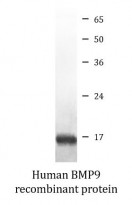ARG70095
Human BMP9 recombinant protein (Active) (His-tagged, N-ter)
Human BMP9 recombinant protein (Active) (His-tagged, N-ter) for SDS-PAGE
Overview
| Product Description | E. coli expressed, His-tagged (N-ter) Active Human BMP9 recombinant protein |
|---|---|
| Tested Application | SDS-PAGE |
| Target Name | BMP9 |
| Species | Human |
| A.A. Sequence | Ser320 - Arg429 |
| Expression System | E. coli |
| Activity | Active |
| Activity Note | Determined by its ability to induce alkaline phosphatase production by ATDC5 cells. The ED50 for this effect is < 0.4 ng/mL. |
| Alternate Names | GDF-2; BMP-9; Growth/differentiation factor 2; BMP9; Bone morphogenetic protein 9; HHT5 |
Properties
| Form | Powder |
|---|---|
| Purification Note | Endotoxin level is < 0.01 EU/µg of the protein, as determined by the LAL test. |
| Purity | > 98% (by SDS-PAGE) |
| Buffer | 20 mM sodium citrate and 0.2 M NaCl (pH 3.5) |
| Reconstitution | It is recommended to reconstitute the lyophilized protein in 4 mM HCl to a concentration not less than 200 μg/mL and incubate the stock solution for at least 20 min at room temperature to make sure the protein is dissolved completely. |
| Storage Instruction | For long term, lyophilized protein should be stored at -20°C or -80°C. After reconstitution, aliquot and store at -20°C or -80°C for up to one month. Storage in frost free freezers is not recommended. Avoid repeated freeze/thaw cycles. Suggest spin the vial prior to opening. |
| Note | For laboratory research only, not for drug, diagnostic or other use. |
Bioinformation
| Gene Symbol | GDF2 |
|---|---|
| Gene Full Name | growth differentiation factor 2 |
| Background | The protein encoded by this gene is a member of the bone morphogenetic protein (BMP) family and the TGF-beta superfamily. This group of proteins is characterized by a polybasic proteolytic processing site which is cleaved to produce a mature protein containing seven conserved cysteine residues. The members of this family are regulators of cell growth and differentiation in both embryonic and adult tissues. Studies in rodents suggest that this protein plays a role in the adult liver and in differentiation of cholinergic central nervous system neurons. Mutations in this gene are associated with hereditary hemorrhagic telangiectasia. [provided by RefSeq, Jan 2014] |
| Function | Potent circulating inhibitor of angiogenesis. Could be involved in bone formation. Signals through the type I activin receptor ACVRL1 but not other Alks. Signaling through SMAD1 in endothelial cells requires TGF-beta coreceptor endoglin/ENG. [UniProt] |
| Cellular Localization | Secreted. [UniProt] |
Images (1) Click the Picture to Zoom In






